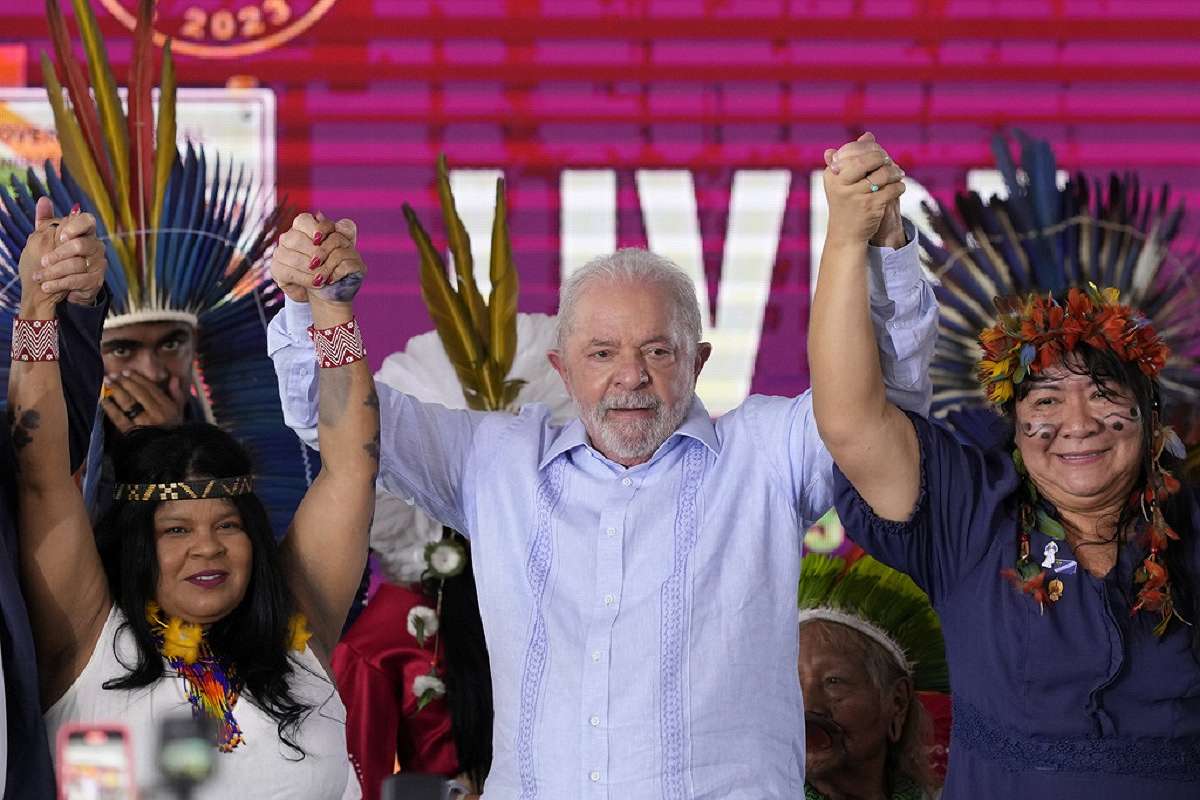
Brazilian President Luiz Inacio Lula da Silva, center, stands between Indigenous Peoples Minister Sonia Guajajara, left, and National Indigenous Foundation President Joenia Wapichana at the closing of the annual Terra Livre, or Free Land Indigenous Encampment in Brasilia, Brazil, Friday, April 28, 2023.
16:50 JST, April 29, 2023
BRASÍLIA, Brazil (AP) — Brazil President Luiz Inácio Lula da Silva on Friday granted official recognition of nearly 800 square miles of Indigenous lands, most of it in the Amazon, in a move that seeks to safeguard critical rainforest from the unchecked exploitation that marked his predecessor’s administration.
Lula’s action was partial delivery on his promises to the Indigenous supporters and environmentally minded voters who lifted him to a narrow victory last year over far-right President Jair Bolsonaro, who had encouraged widespread development of the Amazon — both legal and illegal — and pledged not to grant “one more inch” of land to Indigenous peoples.
The land remains under the federal government’s jurisdiction, but the designation grants Indigenous peoples the right to use it in their traditional manner. Mining activities are prohibited, and commercial farming and logging require specific authorizations. And non-Indigenous people are forbidden from engaging in any economic activity on Indigenous lands.
Kleber Karipuna, executive coordinator at Indigenous people’s organization Apib, called it a welcome shift after four years of threats and invasions targeting Indigenous territories under Bolsonaro.
“For us, it is a very significant process of restarting,” he said. “Of course, there are still other lands that can be advanced.”
The Amazon rainforest, covering an area twice the size of India, holds tremendous amounts of carbon and is a crucial buffer against climate change. Studies have shown that Indigenous-controlled forests are the best-preserved in the Brazilian Amazon.
But deforestation surged to a 15-year high during the Bolsonaro years, with destruction largely caused by illegal miners and land-robbers. Destruction in the eastern Amazon has been so extensive that it has become a carbon source, rather than a carbon sink.
The designations granted Friday don’t assure protection for the rainforest, with Bolsonaro allies still in charge of a majority of Amazon states. But Lula has shown a willingness to back up his rhetoric with action. In February, armed government officials began ejecting illegal gold miners from Yanomami Indigenous territory in the northwest corner of Brazil’s Amazon.
The six newly recognized territories amount to an area larger than Los Angeles and New York City combined. Lula announced it to a chanting crowd at the Free Land Camp, an annual weeklong encampment of Indigenous people in the capital of Brasilia that includes hundreds of tents on the main esplanade with Indigenous people of various ethnicities gathering to dance, sing, sell handicrafts and hold political demonstrations.
“We are going to legalize Indigenous lands. It is a process that takes a little while, because it has to go through many hands,” Lula said. “I don’t want any Indigenous territory to be left without demarcation during my government. That is the commitment I made to you.”
For some Indigenous people, Friday’s announcement was disappointingly small. The country has 733 territories with cases for demarcation pending before the federal government; the newly recognized territories accounted for just 6% of that number, according to Socio-Environmental Institute, a nonprofit.
In January, Lula’s government had pledged to create 14 new territories in the short term.
Among lands that missed out was the Barra Velha territory of the Pataxó people in southern Bahia state. Renato Atxuab, a Pataxó leader, said “this government that we supported, that we helped build” must demarcate their land as soon as possible to prevent invasions by outsiders.
Already there are conflicts involving agribusiness and land-grabbers, he said, and drug traffickers have been moving in, too.
Atxuab said he has met with the Indigenous Peoples minister — a newly created position under Lula’s government — but has not been given any date for his land’s demarcation.
The largest new area is located in the Amazonas state. The Nadöb people’s Uneiuxi Indigenous Territory has been expanded by 37% to 554,000 hectares (2,100 square miles) of primary rainforest. It is in a remote area — from the main village, it takes four days to travel to the closest city in a low-powered motor boat, the most common mode of transportation in the region.
“The demarcation will make the Nadöb people feel safe and protected within our territory. That is where we live, fish, hunt, and gather fruits. We want to continue there, like our ancestors,” chief Eduardo Castelo, 45, told The Associated Press in a phone interview. “We don’t want the impact of the whites on our territory.”
"News Services" POPULAR ARTICLE
-

American Playwright Jeremy O. Harris Arrested in Japan on Alleged Drug Smuggling
-

Japan’s Nikkei Stock Average as JGB Yields, Yen Rise on Rate-Hike Bets
-

Japan’s Nikkei Stock Average Licks Wounds after Selloff Sparked by BOJ Hike Bets (UPDATE 1)
-

Japanese Bond Yields Zoom, Stocks Slide as Rate Hike Looms
-

Japan’s Nikkei Stock Average Buoyed by Stable Yen; SoftBank’s Slide Caps Gains (UPDATE 1)
JN ACCESS RANKING
-

Keidanren Chairman Yoshinobu Tsutsui Visits Kashiwazaki-Kariwa Nuclear Power Plant; Inspects New Emergency Safety System
-

Imports of Rare Earths from China Facing Delays, May Be Caused by Deterioration of Japan-China Relations
-

University of Tokyo Professor Discusses Japanese Economic Security in Interview Ahead of Forum
-

Japan Pulls out of Vietnam Nuclear Project, Complicating Hanoi’s Power Plans
-

Govt Aims to Expand NISA Program Lineup, Abolish Age Restriction

























